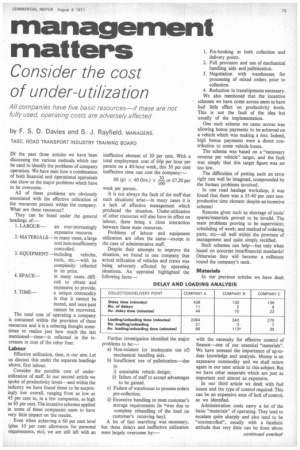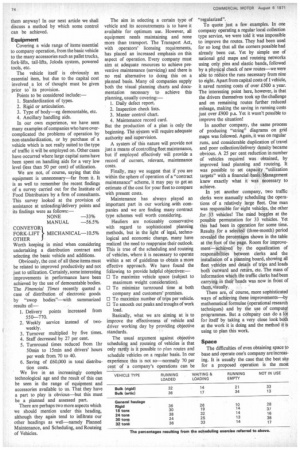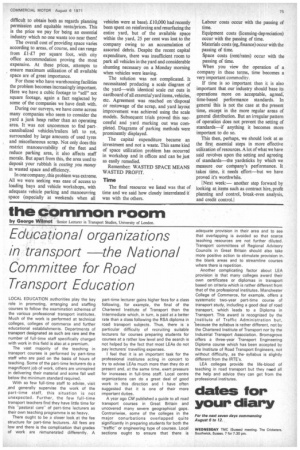management matters
Page 75

Page 76

Page 77

If you've noticed an error in this article please click here to report it so we can fix it.
Consider the cost of under-utilization
All companies have five basic resources—if these are not fully used, operating costs are adversely affected by F. S. D. Davies and S. J. Rayfield, MANAGERS. TASC, ROAD TRANSPORT INDUSTRY TRAINING BOARD
IN the past three articles we have been discussing the various methods which can be used to identify the problems of company operation. We have seen how a combination of both financial and operational appraisals can show us the major problems which have to be overcome.
All of these problems are obviously associated with the effective utilization of the resources present within the company. What are these resources?
They can be listed under the general headings of:— 1. LABOUR— an ever-increasingly expensive resource.
2. MATERIALS—in many cases, a large cost item insufficiently controlled.
3. EQUIPMENT—including vehicles, tools, etc,—with its complexity reflected in its price.
4. SPACE— in many cases, difficult to obtain and expensive to provide
5. TIME— a unique commodity in that it cannot be stored, and once past cannot be recovered. The total cost of operating a company is contained within the provision of these resources and it is a sobering thought sometimes to realize just how much the last mentioned—time—is reflected in the increases in cost of the other four.
Labour Effective utilization, then, is our aim. Let us discuss this under the separate headings above, first labour.
Consider the possible cost of underutilization of staff. In our second article we spoke of productivity levels—and within the industry we have found these to be surprisingly low overall, ranging from as low as 45 per cent to, in a few companies, as high as 85 per cent. The incentive schemes applied in some of these companies seem to have very little impact on the results.
Even when achieving a 60 per cent level (plus 10 per cent allowance for personal requirements, etc), we are still left with an ineffective element of 30 per cent. With a total employment cost of 60p per hour per person on a 40-hour week, this 30 per cent ineffective time can cost the company:
60 (p) X 40 (hrs.) x —30 or £7.20 per
week per person.
It is not always the fault of the staff that such situations arise—in many cases it is a lack of effective management which produced the situation. Under-utilization of other resources will also have its effect on labour, there being a close interaction between these main resources.
Problems of labour and equipment utilization are often the same—except in the case of administrative staff.
Despite their attempts to improve the situation, we found in one company that actual utilization of vehicles and crews was being adversely affected by operating situations. An appraisal highlighted the following facts:—
Further investigation identified the major problems to be:—
a) Non-existent (or inadequate use of) mechanical handling aids.
b) Insufficient use of palletization—due to i) unsuitable vehicle design; failure of staff to accept advantages to be gained.
c) Failure of warehouse to process orders pre-collection.
d) Excessive handling to meet customer's storage requirements (ie *was due to complete rehandling of the load on customer's receiving bay).
A lot of fact searching was necessary, but these delays and ineffective utilization were largely overcome by:— I. Pre-booking at both collection and delivery points.
2. Full provision and use of mechanical handling aids and palletization.
3. Negotiation with warehouses for processing of mixed orders prior to collection.
4. Reduction in transhipments necessary.
We also mentioned that the incentive schemes we have come across seem to have had little effect on productivity levels. This is not the fault of the idea but usually of the implementation.
One such scheme we came across was allowing bonus payments to be achieved on a vehicle which was making a loss. Indeed, high bonus payments were a direct contribution to some vehicle losses.
The scheme was based on a "necessary revenue per vehicle" target, and the fault was simply that this target figure was set too low.
The difficulties of putting such an error right can well be imagined, compounded by the human problems involved.
In one road haulage workshop. it was found that there was a 35-40 per cent nonproductive time element despite an incentive scheme!
Reasons given such as shortage of tools/ spares/materials proved to be invalid. The main problems proving to be supervision; scheduling of work; and method of ordering parts, etc—all well within the province of management and quite simply rectified.
Such schemes can help—but only when based on accurate time/financial standards! Otherwise they will become a millstone round the company's neck.
with the necessity for effective control of finance—one of our essential "materials". We have stressed the importance of up-todate knowledge and analysis. Money is an expensive commodity and we shall return again in our next article to this subject. But we have other materials which are just as important and almost as expensive.
In our third article we dealt with fuel issues and the type of control required. This can be an expensive area of lack of control, as we identified.
Administration costs carry a lot of the basic "materials" of operating. They tend to escalate quite sharply and also tend to be "uncontrolled", usually with a fatalistic attitude that very little can be done about them anyway! In our next article we shall discuss a method by which some control can be achieved.
Equipment Covering a wide range of items essential to company operation, from the basic vehicle to the many accessories such as pallet trucks, fork-lifts, tail-lifts, Joloda system, powered tools, etc.
The vehicle itself is obviously an essential item, but due to the capital cost involved , a lot of thought must be given prior to its provision.
Points to be considered include: 1. Standardization of types.
2. Rigid or articulation.
3. Type of body—eg demountable, etc.
4. Ancillary handling aids.
In our own experience, we have seen many examples of companies who have overcomplicated the problems of operation by non-standardization, or by purchase of a vehicle which is not really suited to the type of traffic it will be employed on. Other cases have occurred where large capital sums have been spent on handling aids for a very low level (less than 50 per cent) of utilization.
We are not, of course, saying that this equipment is unnecessary—far from it. It is as well to remember the recent findings of a survey carried out for the Institute of Food Distributors by a firm of consultants. This survey looked at the provision of assistance at unloading/delivery points and its findings were as follows:—
NONE —33% MANUAL —56.5% CONVEYOR} CONVEYOR} FORK-LIFT MECHANICAL-10.5% OTHER Worth keeping in mind when considering undertaking a distribution contract and selecting the basic vehicle and additions.
Obviously, the cost of all these items must be related to improved productivity and not just to utilization. Certainly, some interesting improvements in performance have been achieved by the use of demountable bodies. The Financial Times recently quoted a case of distribution of electronic goods by "swop bodies"—with summarized results of: 1. Delivery points increased from 550-770.
2. Weekly service instead of twoweekly.
3. Turnover multiplied by five times.
4. Staff decreased by 27 per cent.
5. Turnround times reduced from thr 50min to 15min and drivers' hours per week from 70 to 40.
6. Saving of £60,000 in total distribution costs.
We live in an increasingly complex technological age and the result of this can be seen in the range of equipment and accessories available to us. That they have a part to play is obvious—but this must be a planned and assessed part.
There are perhaps two more aspects which we should mention under this heading, although they again tend to infiltrate our other headings as well----namely Planned Maintenance, and Scheduling, and Routeing of Vehicles. The aim in selecting a certain type of vehicle and its accoutrements is to have it available for optimum use. However, all equipment needs maintaining and none more than transport. The Transport Act, with operators' licensing requirements. has placed an increased emphasis on this aspect of operation. Every company must aim at adequate resources to achieve preventive maintenance (servicing) and there is no real alternative to doing this on a planned basis. Many oil companies supply both the visual planning charts and documentation necessary to achieve this planning, usually covering: 1. Daily defect report.
2. Inspection check lists.
3. Master control chart.
4. Maintenance record card.
But the production of a plan is only the beginning. The system will require adequate authority and supervision.
A system of this nature will provide not just a means of controlling fleet maintenance, but if employed effectively will provide a record of current, relevant, maintenance costs.
Finally, may we suggest that if you are within the sphere of operation of a "contract maintenance" scheme, it may pay to get an estimate of the cost for your fleet to compare with present costs.
Maintenance has always played an important part in our working .with companies and we are finding many contract type schemes well worth considering.
Hauliers are noticeably conservative with regard to sophisticated planning methods, but in the light of legal, technological and economic change, many have realized the need to reappraise their outlook. This is true of the scheduling and routeing of vehicles, where it is necessary to operate within a set of guidelines to obtain a more effective approach. We have found the following to provide helpful objectives:— ID To maximize vehicle space (subject to maximum weight consideration).
D To minimize turnround time at both company and customers' premises.
ID To maximize number of trips per vehicle. O To smooth out peaks and troughs of work load.
Basically, what we are aiming at is to improve the effectiveness of vehicle and driver working day by providing objective standards.
The usual argument against objective scheduling and routeing of vehicles is that only rarely is it possible to plan routes and schedule vehicles on a regular basis. In our experience this is not so—normally 70 per cent of a company's operations can be To quote just a few examples. In one company operating a regular local collection type service, we were told it was impossible to improve the routes. They had been used for so long that all the corners possible had already been cut. Yet by simple use of national grid maps and routeing networks using only pins and elastic bands, followed by a physical check of new routes—we were able to reduce the runs necessary from nine to eight. Apart from capital costs of 1 vehicle, it saved running costs of over £500 a year. The interesting point here, however, is that the drivers themselves took up the challenge and on remaining routes further reduced mileage, making the saving in running costs just over £900 p.a. Yet it wasn't possible to improve the situation!
In another company, the same process of producing "string" diagrams on grid maps was followed. Again, it was on regular runs, and considerable duplication of travel and poor collection/delivery density became obvious. A 25 per cent reduction in number of vehicles required was obtained, by improved load planning and routeing. It was possible to set capacity "utilization targets" with a financial basis. Management knew exactly what it was necessary to achieve.
In yet another company, two traffic clerks were manually scheduling the operations of a relatively large fleet. One man was responsible for eight vehicles, the other for 33 vehicles! The mind boggles at the possible permutation for 33 vehicles. Yet this had been in operation for some time. Results for a selected (three-month) period revealed the percentages shown in the table at the foot of the page. Room for improvement—achieved by the equalization of responsibilities between clerks and the installation of a planning board, showing all fleet vehicles and details of trips and loads both outward and return, etc. The mass of information which the traffic clerks had been carrying in their heads was now in front of them, visually.
There are, of course, more sophisticated ways of achieving these improvements—by mathematical formulae (operational research techniques) and by the use of computer programmes. But a coinpany can do a lot for itself by taking a very close look both at the work it is doing and the method it is using to plan this work.
Space The difficulties of even obtaining space to base and operate one's company are increasing. It is usually the case that the best site for a proposed operation is the most difficult to obtain both as regards planning permission and equitable rents/prices. This is the price we pay for being an essential industry which no one wants too near them!
The overall cost of providing space varies according to areas, of course, and can range from L1-£7 per square foot, with city office accommodation proving the most expensive. At these prices, attempts to ensure maximum utilization of all available space are of great importance.
For those who have warehousing facilities the problem becomes increasingly important. Here we have a cubic footage to "sell" not square footage. again a fact neglected by some of the companies we have dealt with.
During our surveys, we have come across many companies who seem to consider the yard a junk heap rather than an operating area. It was not uncommon to find partcannibalized vehicles/trailers left to rot, surrounded by large amounts of used tyres and miscellaneous scrap. Not only does this restrict manoeuvrability of the fleet and reduce parking area, it also affects staff morale. But apart from this, the area used to deposit your rubbish is costing you money in wasted space and efficiency.
In one company, this problem was extreme. All we were seeking was ease of access to loading bays and vehicle workshops, with adequate vehicle parking and manoeuvring space (especially at weekends when all vehicles were at base). £10,000 had recently been spent on reinforcing and resurfacing the entire yard, but of the available space within the yard, 25 per cent was lost to the company owing to an accumulation of assorted debris. Despite the recent capital expenditure, there was insufficient room to park all vehicles in the yard and considerable shunting necessary on a Monday morning when vehicles were leaving.
The solution was not complicated. It necessitated producing a scale diagram of the yard—with identical scale cut outs in cardboard of all essential yard items, vehicles, etc. Agreement was reached on disposal or restowage of the scrap, and yard layout improvement was achieved using the scale models. Subsequent trials proved this successful and yard marking out was completed. Diagrams of parking methods were prominently displayed.
The capital expenditure became an investment and not a waste. This same kind of space utilization problem has occurred in workshop and in offices and can be just as easily remedied.
Remember: WASTED SPACE MEANS WASTED PROFIT.
Time The final resource we listed was that of time and we said how closely interrelated it was with the others. Labour costs occur with the passing of time.
Equipment costs (licensing-depreciation) occur with the passing of time.
Materials costs (eg, finance) occur with the passing of time.
Space costs (rent/rates) occur with the passing of time.
When you view the operation of a company in these terms, time becomes a very important commodity.
If time is so important then it is also important that our industry should base its operations more on acceptable, agreed; time-based performance standards. In general this is not the case at the present time, except in the more regular areas of general distribution. But an irregular pattern of operation does not prevent the setting of standards if anything it becomes more important to do so.
This then, perhaps, we should look at as the first essential steps in more effective utilization of resources. A lot of what we have said revolves upon the setting and agreeing of standards—the yardsticks by which we measure our company's performance. It takes time, it needs effort—but we have proved it's worthwhile.
[Next week:— another step forward by looking at items such as contract hire, profit planning and control. break-even analysis, and credit control. 1




























































































































